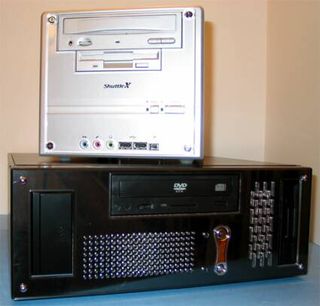2003 Winter Case Review Part 1: MicroATX Case Madness
Is A MicroATX Solution Worth It?
While reviewing the MicroATX cases in this review, one has to ask the question, "Is MicroATX worth it?" The answer to this question is actually quite complex. If you choose a MicroATX case that does support regular full-height PCI/AGP cards, you will likely be forced to choose a case that is almost half the size of a regular mid-tower ATX case. While it is true that most MicroATX cases are slimmer and not quite as tall or thick, their form factor "pales" in comparison to the "Barebones Cube Type System" options that are available.

A comparison of the Shuttle SN45G and the Super Flower/TTGI TT-101 test system that we built. It is clear that the Shuttle is considerably smaller in overall size than the TT-101. Nonetheless, the TT-101 is still an excellent looking case and offers an attractive alternative to the many of the barebones "cube type" systems.
While MicroATX systems do make a fine fit for many applications, it still may not be the ultimate in compact systems. In order to get to a form factor that is closest to the "cube type" systems, the height of the PCI/AGP cards do seem to be the problem. If you can live with an all integrated motherboard solution, then several of the form factors here do present an interesting alternative to the "cube type" options. Many readers continue to ask why they can't use a MicroATX motherboard in a "cube type" case, and the answer is quite simple: it will not fit.
The restrictions of the MicroATX form factor make it next to impossible to design a "cube type" case that will fit with a MicroATX motherboard installed. It comes as no surprise that none of the case manufacturers have been able to achieve this miracle yet; the MicroATX motherboard is just too large. Even with these restrictions, case manufacturers have attempted to create the smallest case designs within the MicroATX form factor, and due to this you can expect some frustration when assembling these cases. The inside of these MicroATX cases have cramped quarters with little room to spare.
Depending on your application and what you are looking to achieve, a MicroATX may or may not offer you more expansion room or options than the typical "cube type" system. It is important to understand that if you are looking for a solution for a home theater type application, you may not achieve the balance of a compact look and the support for expansion cards that you desire. Still, many are attracted to this option, and it while it will continue to compete against the "cube type" options, it is clear that the momentum the MicroATX form factor is gaining may be very slow in comparison to the advantages of selecting one of the barebones "cube type" solutions that are offered by a variety of motherboard manufacturers. While these solutions are customized for the motherboard and case that they offer, it still may be far better to consider than many of the other options offered by the typical MicroATX case.
Stay On the Cutting Edge: Get the Tom's Hardware Newsletter
Join the experts who read Tom's Hardware for the inside track on enthusiast PC tech news — and have for over 25 years. We'll send breaking news and in-depth reviews of CPUs, GPUs, AI, maker hardware and more straight to your inbox.
Current page: Is A MicroATX Solution Worth It?
Prev Page MicroATX Mayhem Next Page The Review ProcessMost Popular



